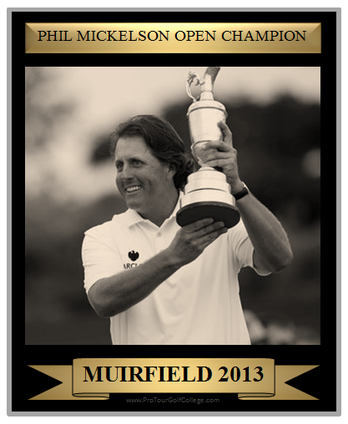 What a great win by Phil Mickelson last week at Muirfield to win The Open Championship. The last six holes he played was some of the best golf seen for a long time. Winning the Scottish Open and British Open back to back is a huge accomplishment and he is the first to do the double in the same year, and only the second lefty to lift the Claret Jug. The first was Bob Charles of New Zealand in 1963. With the course playing hard and fast some of the fairways looked like they were running faster than the greens. Phil made a decision before the start of the tournament that set the foundation for him to be in contention on the final day. He left the driver out of the bag for the whole week. Carrying two 3 woods, one for driving (stronger loft) and one for the tight fairways. This combined with a renewed confidence in his putting which we all witnessed in those closing six holes (where he made four birdies) and separated himself from the field to win by 3 strokes. The 42 year old has had a remarkable career so far, and winning his 5th major now elevates him into the upper echelons of great golfers who have played this game. So where does he stand amongst the greats? Well he hasn't cracked the top ten in my rankings as yet but he still has a few years to add to his tally of 5 Majors. So who is the top ten and not necessarily in order, as that will be another article in itself. That is a very impressive list of golfers and their achievements in Majors, and Tiger is the only active player on that list. Phil at the moment is hot on the heels of another group of five who have won between 5 and 7 Majors in their career. All are house hold names, even after a hundred years after winning their last major. These five have set tournament records that up to this day that are still standing. They're legends from where they came from, and their legacy will live on for years to come. Again not necessary in order, and they all deserve their place for their deeds on and off the course. Now Phil Mickelson has had a distinguished career both as an elite amateur golfer and also as a professional golfer. From his college days at Arizona State University where he graduated in 1992 and where he won 3 NCAA individual titles, as well as the US Amateur Championship in 1990. The first left handed golfer to win the title. To top off his amateur career he won the Northern Telecom Open in Tucson in 1991 on the PGA Tour as an amateur and is only the sixth amateur to win on the PGA Tour. After turning professional in 1992 it took him 12 years to win his 1st Major at the 2004 US Masters, followed by the 2005 US PGA Championship and another two Masters in 2008 and 2010. His win at last weeks Open makes his total five. But it will always also be his near misses and record six 2nd place finishes at the US Open, (only Major he has not won) that he is remembered for. His go for broke approach makes him a favorite with the crowds. His bounce back from adversity mental make up is what his fellow professionals admire. Phil has won 42 times on the PGA Tour and 9 times on the European Tour. With all he has achieved one thing that has eluded him is the number one position in the World Golf Rankings. He has been number two numerous times but never in the top position.  At 43 years old he has to ride the momentum he has created at the Scottish and British Open's to win more majors as time is not on his side. He is still physically in good shape although he was diagnosed in 2010 with Psomatic Arthritis has but made a full recovery with treatment. And Phil still can keep up with the "bombers" on tour combined with argubly the best approach wedge and scrambling game will make him a top three pick for winning another major in the near future. To get into the elite top ten Phil will have to win at least another 3 majors and that elusive US Open to complete the modern day "Grand Slam" of the US Masters, US Open, British Open and US PGA. We look forward to the last major of the year when the US PGA is played at the Oak Hill Country Club East Course in Rochester, New York from the 8th to 11th August. Can Phil make it two in a row? Definitely exciting times ahead in professional golf. David Milne and Lawrie Montague - Pro Tour Golf College Your Success On Tour is Our Business "It doesn’t take a Rhodes Scholar to work out that we are very bad at predicting future events in general, and sadly we all too often play this game bouncing from past events to future events as skilfully as Tiger Woods is at holing clutch putts".  Playing golf can be likened to riding a wave of pure emotion for many golfers, where from moment to moment you can go from the highest high to the lowest low as a result of the way you play. You hit the perfect shot that soars effortlessly up into the sky and starts tracking like a laser guided missile straight for the pin. You are completely immersed in the shot as you watch it travel closer and closer to your target only to witness it bury deep into the side of the bunker that was protecting the pin placement. A simple mistake in club choice has left your perfect shot five yards short of perfect in the most dire situation. How quickly it can change. I know as you read this that you can truly relate to it because this scenario plays out over and over from novice through to professional golfer every day. Isn't it interesting that for many of us we so easily remember these less-than-perfect golf shots that we hit? There’s no doubt about it; there’s pain and anguish playing the game of golf and let’s face it, we wouldn’t want to have it any other way would we? 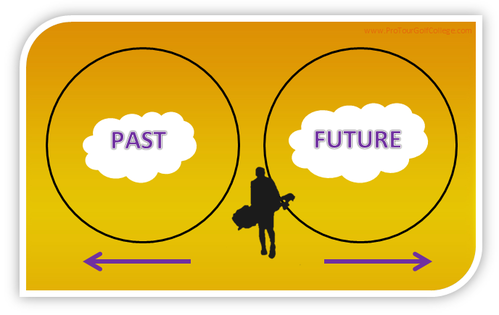 Well, I hear you say that you would prefer a little less torment and a lot more enjoyment when you play, and I can understand how you would want that. In today’s article I’m going to discuss a simple principle that will help you to deal with the ups and downs of golf like an expert. As a result of learning this simple principle and applying it consistently to your game you will greatly improve your golf scores. We hear so often in golf telecasts about the importance of developing the right attitude for playing golf and yet one of the problems with playing golf is that you grow up with one considerable daily challenge that could possibly be the source of many of the problems serious golfers face. Virtually all the information you are exposed to every day of your life is focused on past events or future events.The news and current affairs programs milk recent events for all that they're worth, until another story comes along, and then off they go again. If you are like me you've grown up in front of a TV or a radio listening to news channels continually discuss significant event days after they happen. Today with the phenomenal speed of the internet a new generation of golfers is facing the same problem only it has accelerated one hundred fold. This perpetual cycle of past - to - future - thinking becomes a normal way of thinking for many; including golfers.  The golf commentators also talk about possible future scenarios as if they had a crystal ball they were gazing into, making predictions about how such and such a golfer is likely to play the last few holes in the tournament. It doesn’t take a Rhodes Scholar to work out that we are very bad at predicting future events in general, and quite brilliant at lamenting over past events. Sadly we all too often play this game bouncing from past events to future events as skilfully as Tiger Woods is at holing clutch putts. But here's the thing; we do not know what is going to happen from one moment to the next. This is a basic fact about human existence that is as consistent as the sun rising and setting every day. However, what we do naturally and really well is imagine outcomes that we would like to have (or not have), and then we go after them as if real.  They are not real, but here’s the point; if we emotionalize and personalize them enough, they become real for us. In other words if we practice the emotional behavior, we get it! Good or bad, right or wrong, or positive or negative. This important principle basically says that what we emotionalize and personalize consistently we tend to remember. The unconscious mind makes no distinction between a good or bad result, it just responds to the stimulus, if provoked enough. If you get overly emotional over a good or positive result, it stamps or marks (remembers) the moment; and if you get overly emotional over a bad or negative result, it stamps or marks the moment.  So you should understand that the idea is to emotionalize results you want, NOT results that you don't want. Now I hear you saying that you already know this, and you might, however this is something that you want to develop into a consistent behavior, not just have an understanding of and/or support the theory. Have you noticed how often Tiger Woods fist pumps when he holes a putt? It doesn't matter whether it's a short putt or long putt, he stamps or marks the moment. This 'clench and pump' fist pumping technique is used for marking or remembering the moment, and is sometimes referred to as anchoring. The idea is to clench your fist just as you reach the peak moment of the experience (say as the ball is tracking the hole), and cock your elbow (hold it as its going into the hole) and then pump your fist as it hits the bottom. Marking this powerful moment in time and doing it over and over will help you to get into the ideal performance state faster. Watch carefully next time Tiger or Phil (in particular) hole a putt and you will see the sequence played out over and over. The Simple 3 Step Peak Performance Technique
Step 1. Clench The Fist Step 2. Cock The Elbow Step 3. Release The Punch In the image above the more you anchor, the more in the moment you are, (not in the past or in the future) and the key is to anchor results you are happy with, NOT the one's you're not happy with. The beauty of anchoring is that it is something we already do many times a day, in-fact anytime you engage well learned habits that put you into either negative or positive states, you are anchoring or reinforcing the behavior - mentally and physically. When you listen to your favorite music for example, and it puts you into a good mood, you are using a music anchor to change your mood to positive, and when you get frustrated or even angry because someone has cut you off in traffic you are also using an anchor to change your mood. An anchor is simply a strategy for getting you into a productive or unproductive state, and you need to be very careful how you're responding to events on the golf course, because you could be anchoring a less-than-useful state, which could be holding you back from making progress with your game. When you play each golf shot you have a simple choice to make; will I anchor the result of the shot to remember it, or will I ignore it because I don't want to remember it? A simple choice to make but which one will you take? Lawrie Montague and David Milne - Pro Tour Golf College Your Success On Tour is Our Business “For most professional golfers it is a daily grind playing in small tournaments for even smaller purses where you are nearly always staring at more month at the end of the money.”  Steven Jeffress Playing in His First Major at 37 Steven Jeffress Playing in His First Major at 37 Imagine just for a moment getting a chance to play in your first major golf championship, wouldn’t that be a fantastic moment in your life? Now imagine that you are 37 years old and playing in your first major golf championship. Imagine that you've been playing on professional golf tours around the world since your early 20’s and after hitting thousands of golf shots in pro tournaments you finally get your chance to play in the oldest and greatest golf championship of them all; The Open Championship. Aussie golfer Steven Jeffress has stepped up to the major leagues this week after qualifying earlier in the year at Kingston Heath Golf Course in Melbourne where he gained one of just three spots to play in the Open Championship at Muirfield Golf Club in Scotland. Steven was the second best qualifier with a score of 9 under for two rounds around one of Australia’s most renowned golf courses. How tough was it to qualify for the Open Championship in Australia this year? Well, to get your ticket into the Open you needed to shoot 8 under or better for 2 days. Steven is one of 156 players competing at Muirfield this week with the leading 70 players, and those tied for 70th place after two rounds, qualifying for the final 36 holes.  I wrote about Steven in August last year (read the article here) as someone with tremendous grit and determination who at the time was coming out of a career threatening slump where for over a year he had lost his confidence, his golf game and had made almost no money. He was on the brink of retiring from playing professional tour golf and finding something else to do. And who could blame him when professional golf is arguably the toughest of all professional sports to make it in – let alone just make a living. In most big time professional sports when you make it to the big leagues you sign contracts for millions of dollars, or you get paid gigantic salaries every week. This is simply not the case in professional tour golf where a very small percentage of professional golfers earn mega contracts with big brand companies, and also big checks for playing well in the big tournaments around the world. For most professional golfers it is a daily grind playing in small tournaments for even smaller purses, where you are nearly always staring at more month at the end of your money. We so easily talk about how this great golfer or that great golfer is going to perform in a major championship, but we pay no mind to the professionals like Steven Jeffress and others who are still trying desperately to climb their success ladder and achieve their moment of significance. 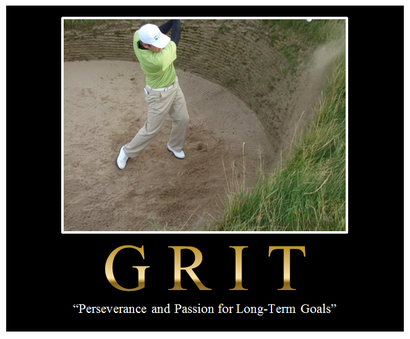 The key to Steven's success is described by Angela Duckworth and her colleagues in their paper; Grit: Perseverance and Passion for Long Term Goals. In her paper Duckworth and colleagues suggest that people who possess a drive to tirelessly work through the challenges, and adversity to achieve their goals are also uniquely positioned to reach higher achievements than others who lack similar stamina. Their definition of Grit is defined as follows: “perseverance and passion for long-term goals.” Zeal and Persistence of Motive and Effort Specifically, those individuals who were identified as more successful and influential than their contempories typically possessed traits above and beyond that of normal ability. While ability was still critically important, these individuals also possessed “zeal” (which is described as great energy or enthusiasm in pursuit of a cause or objective) and “persistence of motive and effort.” Duckworth believes this dual-component of Grit to be a crucial difference from similar traits. Here's the Key Point... Grit is described as a stable trait that does not require immediate positive feedback. Golfers high in Grit are able to maintain their determination and motivation over long periods despite experiences with failure and adversity. Tour professionals that don't give up easily have passion and commitment towards long-term objectives and this is the overriding factor that provides the stamina required to “stay the course” even through the constant challenges and set-backs of playing professional golf. Essentially, the Grittier person (golfer) is focused on winning the marathon, not the sprint. You can read more about Grit here: http://en.wikipedia.org/wiki/Grit_(personality_trait) Steven Jeffress and many of his colleagues are the embodiment of what a professional tour player is; a gritty tough as nails competitor; with an extremely resilient nature, who will just keep turning up to play. This is the most important factor in golf success; you have to keep turning up to play, and keep trying to improve your performance. The easiest thing to do is give up when things are not going the way they should and many will do just that. And Steven is playing in the greatest golf championship of them all because he just keeps turning up to play. Lawrie Montague and David Milne - Pro Tour Golf College Your Success On Tour is Our Business 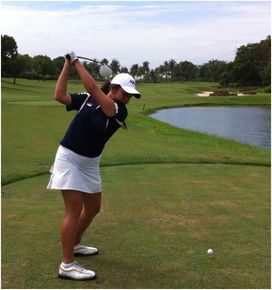 One of our Pro Tour Golf College students Tatiana Wijaya has successfully qualified to play in the USGA Womens Amateur Championship for the second year in a row. For the recently turned 17 year old from Perth Western Australia its a mighty achievement as there were a record 1,170 entries for the event this year being played at The Country Club of Charleston, in South Carolina. And if you think that's a lot, there were over 7,000 entries for the men's championship which is being played this year at The Country Club in Brookline Massachusetts. Both the above championships have been going since 1895 when there were 32 entries for the men's and 13 for the women's. How things have changed since those early years. Both are now truly international events as there are competitors from all parts of the globe. It's only been over the last 15 years that the internationals have been able to claim victory on a regular basis. In the women's championship players from South Korea have claimed the title on numerous occasions and last years winner was Lydia Ko from New Zealand, the youngest winner (15 years old) in the history of the championship. In 1995 Pro Tour Golf College co-director Lawrie Montague had one of his golfers Ann Marie-Knight contest the final of the US Amateur, and unfortunately lost 5 and 4 to the winner Kelli Kuehne. In the men's Championship the Americans are hard to beat on home soil. But over the last ten years five internationals have managed to put their name on the trophy. 1. Nick Flannagan (Australia) 2. Edoardo Molinari (Italy) 3. Danny Lee (New Zealand) 4. Ritchie Ramsay (Scotland) 5. Beoung-Hun An (South Korea) These fine golfers have led the way for the international entrants and have gone on to play successfully on professional golf tours around the world. The most famous winners who arguably are also the best players to ever play the game are Bobby Jones (5 titles), Jack Nicklaus (2 titles) and Tiger Woods (3 titles) who won three times in a row in the mid 1990's.  In both championships all players play 36 holes of stroke-play and the top 64 players will then play match play to determine the champion. It's a grueling week of golf, and it will test not just the golf games, but also the physical and mental state of the players - especially those who have to play 36 holes in the final. On numerous occasions more holes were required to determine the winner and Jeff Quinney in 2000 needed 39 holes to beat James Driscoll. Both these players are currently regulars on the PGA Tour. Like all USGA events the courses are set up with a high degree of difficulty and tests every area of the competitors game. With thick rough to catch the offline tee shot and hard fast greens to test the scrambling skills of the competitors and most of all where a par is very precious. Tatiana, now that she has qualified for the Women's Championship, the work she has been doing all year at Pro Tour Golf College will hold her in good stead. Precise short irons and approach wedges, and lots of work on improving her scrambling skills will come in handy. That's not going to be enough though, as getting to the tournament with enough time to do her course charting will be critical. She will first walk the course and thoroughly chart each hole and green. Only then will she play two full practice rounds and together with Lawrie and I using Goggle Earth will set up a game plan for her to confidently use, to give her the best opportunity to do well. Exciting times for the young lady, and with her team around her it will give her a shot at putting her name on the only USGA trophy donated by a foreigner Robert Cox who was a member of the British Parliament in 1896. We wish Tatiana all the very best, and good golfing at the 2013 US Women's Amateur Championship. David Milne and Lawrie Montague - Pro Tour Golf College Your Success On Tour is Our Business  As a parent or coach it is imperative that you have an understanding of what motivates your son, daughter or student to play the game of golf. A research survey completed by a group of children aged 10 to twelve years old ranked the ten most enjoyable factors of why children play sport.The children placed in decreasing order of preference below their reasons for playing sport.
The above preferences are important so as to know the reasons why they play, and also what gives them the most enjoyment in participating in sport. Such an understanding will provide and enable the parent to make golf participation more attractive to their child. This in turn will allow the child to have a more satisfying involvement in the game and lower the chances of them dropping out of the sport. It requires knowing how the junior thinks and learns. Which means you have to observe their body language when they play and practice so as to be able to match their favoured learning style when they are being coached. What I mean is find out if the child's learning style is either more visual (how they see it), kinesthetic (how it feels) or auditory (how they hear it) incorporated it in all their learning of new skills. Remember the professional golf coach/teacher/instructor is not always going to be there when the junior is practicing, so the parent has to take the responsibility of giving the feedback as long it's not in conflict of what the child's professional wants them to be doing. 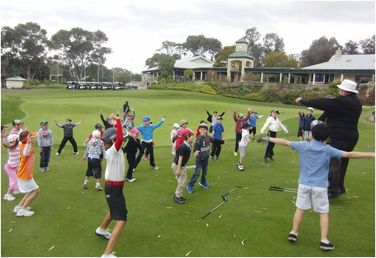 The Junior Program at David Milne Golf Academy The Junior Program at David Milne Golf Academy Apart from developing the basic technical skills, parents can encourage children to contribute to their own learning by helping them to;
It is very important to allow children time to absorb information and transfer it the "unconscious competence" level before introducing the next skill. Be tolerant and provide direction for their enthusiasm. Maintain interest with varied activities, and limit too much talking, as this is a major distraction when a child is learning a new skill. A critical time is when the child goes through adolescence and experience growth spurts. Arms and legs can be disproportionately long and this can cause a lack of coordination and resulting in loss of form. Recognize this as a stage of physical development, and not a technical issue. During this stage avoid large amount of repetitions involving repeated impacts especially on synthetic mats so as to avoid injury as well. This is just an overview of how you can better understand the junior golfer, so follow the above guidelines for a happy relationship with your child and the opportunity of helping them to fulfill some of their amazing potential playing golf. David Milne and Lawrie Montague - Pro Tour Golf College Your Success On Tour is Our Business So isn't it about time we start talking more about what really makes golfers great players, and stop using the word 'talent' so flippantly, which as I've said before is a convenient way of saying “I’m not sure why this guy or girl plays better than everyone else, so let’s just call it talent”. I have yet to meet someone who was born a golfer. I have met many who were born of golfing parents, but as far as I know there are no genes identified as yet that we could call golf genes. Ben Hogan was born of a black smith; Jack Nicklaus was born of a chemist; Bobby Jones was born of an attorney, and Tiger Woods was born of a retired military man. Not one of them was born with a special gene that gave them the ability to play golf; it was simply an acquired set of skills that they have executed in such a way that they achieved more success than many who have played. It's something they got really good at. Not unlike famous people who play music, toss or kick footballs, or run around tracks at the Olympics. So isn't it about time we start talking more about what really makes golfers great players, and stop using the word 'talent' so flippantly, which as I've said before is a convenient way of saying “I’m not sure why this guy or girl plays better than everyone else, so let’s just call it talent”. Talent is a helpful word for describing outcomes that seem unusual or outstanding, but so does the word excellence. Every golfer has experienced excellence at some point of time in their golfing experience, and there are many excellent golfers playing amateur and professional golf, but there is only ever one winner of a tournament at a time. Here's and interesting question. If someone can win more than one time in a year does that make him/her more talented than everyone else in the field? Was it talent that got them over the line, or a lower competitive score average over 4 rounds that did it? What about when they are not winning, or when they are completely out of form or how about when they retire from playing? Are they still talented then. It's seems to be a very convenient word when things are going well. If all highly competent and competitive male and female golfers can chip, pitch, putt, hits greens in regulation and drive the ball from the tee with distance and accuracy then surely what really is at work here is not a question of whether that golfer has talent, but rather can they synchronize all these different skills to create a low score average over four days of competition? So I'm offering you two simple choices for you to consider going forward; 1. You can work on developing your talent for golf or 2. You can work on developing a lower golf score average in tournaments The first one for me is a little vague, don’t you think? The second is easier to understand. If you want to be a successful amateur or professional golfer then forget whether or not you possess the talent for golf success and start working on improving your golf skills to drive your golf scores lower. You acquire golf skills; you are not born with them. Remember this always.  But I hear you saying that you have been told many times that you “haven’t got what it takes”. Really; and the person that shared this wisdom with you would really know right? Have they done it themselves? Maybe they have, and maybe they haven’t. Maybe they failed to become successful at golf and are bitter and twisted about it. And even if they were a successful golfer, (whatever that means) does that mean that you don’t somehow possess the ability to acquire and develop the skills necessary to lower your score average and live your dream of becoming a successful golfer? Of course you can! Ability is aptitude, intelligence and skill. You can improve all of these traits as it relates to getting better at golf.
 Seriously, you can change the way you play if you can change how you see yourself in the context of top level golf. If you see yourself as someone who struggles to put the score on the board then this will manifest itself. If you get upset and angry and disappointed because of your poor play, then this particular strategy will hold you back. Realize that you are not alone with the disappointment. It is par for the course in golf, and especially so in top level amateur and professional golf. But instead of using it as a weapon against yourself, find the inspiration to see it as a way of getting better. No one plays this game perfectly. There’s no room for perfectionists in golf, just realists. This is a game of mistakes, and the real acquired skill of excellent golfers is in reducing the mistakes in each round they play. The skill of golf is to use all your golf skills to craft low golf scores. This is the reality of golf, and also the mind-set you need to develop. Remember it is extremely difficult to find the motivation from others to succeed in golf. It is your responsibility to find the inspiration to continually find ways to acquire and improve your golf skills.
Motivation resides within you, so dare to dream big, bold and inspiring visions of what life could be like for you. Dream without fear and reservation. Your dreams provide you with the inspiration to stretch yourself. No one can do this for you. But also; no one has the right to decide for you whether you will be a success in golf or not, it is entirely up to you. Never give anyone permission to decide your fate in golf, or anything else for that matter! Forget whether you have the talent to succeed in golf or not; find people who embrace your vision of what’s possible, and go to work on it every day by building a bridge from where you are to where you want to be. And if you make mistakes along the way then realize that you are human and mistakes are part of the journey to your success in golf. This is precisely what all that great golfers have done in the past, and I guarantee you that it will still be the formula for personal success in golf in the future. Lawrie Montague and David Milne - Pro Tour Golf College Your Success On Tour is Our Business  Keeping track and making use of baseline statistics can help you with focus and direction in your training. However, often players don’t utilize statistics in detailed enough ways to benefit from them. Basic on course performance stats include:
Players often avoid utilizing statistics for a variety of reasons.
Extra effort is required to incorporate skills tests so players often avoid it completely. In addition, the number of possible statistics to interpret/make use of is almost endless so it is often easier for players to ignore them altogether. Often players will look to work on mechanical flaws in their swing, which will drive the majority of activities they do in their training. They gather feedback by judging the feel of the shot on impact and how close the ball ended up to the target. This is not the most effective feedback but far easier to do then re-coding and reviewing baseline statistics and then using these statistics for direction in training. 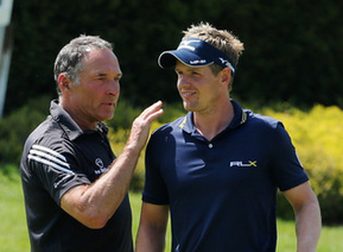 The truth is efficient use of your statistics can instill confidence in your playing ability. Take player Luke Donald for example. He enlisted the help of David Alred, who is famous for his work with star rugby player Jonny Wilkinson (1995 to 2006). Alred worked with Donald on mental preparation, skill acquisition and performance under pressure. He incorporated a performance diary to record stats from exercises designed to make Donald practice under pressure. In Alred’s key drill, Donald plays nine holes with three attempts per shot where each shot is graded. Repeated negative shots require extra work. Exercises such as this act to change your perception of your own ability. The record and review system puts some pressure on the player to perform and provides improved feedback rather than relying just on the feel of the stroke.  Of recent times there has been quite a bit of discussion about a young man who has been playing some fine and consistent golf on the PGA Tour in his rookie season. So I thought I’d take the opportunity to take a closer look at his game to see what we can learn from his style of play so that it might help you to find strategies to become a more competitive amateur or professional golfer. The one defining characteristic of all successful amateur and professional golfers is their ability to produce golf scores under par more times than not, and especially when it matters e.g. the last two rounds in a four round tournament. Jordan Spieth at the tender age of nineteen (the only golfer other than Tiger Woods to have won the U.S. Junior Amateur multiple times) is one such golfer who appears to be on the right track with this part of his game and is currently playing very consistently on the PGA Tour. This is the key to success in golf; your scoring ability particularly in important tournaments and Jordan Spieth proves once and again that before you make the transition from amateur golf to professional golf you have to develop a low scoring ability first. Video taken by Jordan Spieth's coach Cameron McCormick in 2013  Sadly there are too many struggling professional golfers making up the numbers in the field at tournaments because their competitive score average is too high. If we use the Pareto Principle (80/20 principle) to describe this we find that 20 percent of the golfers in a field after making the cut make about 80 percent of the money available in the tournament and 80 percent of the golfers make about 20 percent of the prize money. Now it’s not exactly 80 percent and 20 percent but I think you get the idea. The idea is to play better in the second half of the tournament to make larger checks, and let me be clear from the outset that if you plan to be a professional golfer you are not doing it because of the love of the game so much as you do it because you want to make a great living from hitting golf shots that result in producing a low competitive score average that translates into income. I can assure you that if your intentions are other than what I have just described, then you’re likely to fail. Professional golf is quite simple to understand, like other professional sports that are score based. Lower score average = higher income and higher score average = lower income A low competitive score average rules in golf! So before we get into some detail about Jordan Spieth's on course performances in pro tour events let’s take a quick look at his performances in college before he took the plunge into pro golf to get an idea of his scoring ability. Jordan Spieth’s 2011-2012 University of Texas statistics show that for 37 rounds over 12 events his competitive score average was 70.92 and he was 0.51 strokes below par (see below). He shot par or better 21 times from 37 rounds or 56.7 percent of the time and 43 percent of his rounds were in the 60’s. Now I know there are many fine golfers playing collegiate tournaments in the US but what I noticed in the results was that Jordan Spieth finished high in the standings in many tournaments which suggests that he plays his best when it matters. This is important, and arguably the most important ability you can develop. Many fine young competitive golfers can shoot low scores in amateur tournaments, but in professional golf tournaments you have to shoot low scores consistently, and especially in the last couple of rounds on the weekend to make the big checks. The mind-set you need to develop is to expect better performances in the last two rounds of every tournament you play in. It is about focusing on the process of producing one golf shot after another without distraction. I know that might be a cliche however that is precisely what you have to do. For many struggling elite golfers we have worked with over the years the attitude quite often is that it is more difficult to play well on the weekend (the last two rounds), and statements like “I've got to make the cut” or “I hope I can play well over the weekend” are not uncommon. The key to strong competitive performances in tournaments is to become a strong weekend golfer by focusing on doing a great job of hitting every golf shot to your plan and being emotionally flexible enough to deal with the fact that the game is full of uncertainties. This is something all top tour golfers can do, and in the last two rounds of a pro tournament (just like the first two) they just get on with the job of hitting golf shots without thoughts of "what if". In Jordan Spieth’s case he is particularly good at this going by his last round score average. Jordan Spieth’s statistics tell us that he has a very solid tee to green game with a ranking of 28 for the ball striking category on the PGA Tour which ranks his tee shot distance and accuracy (rank 13) and his greens in regulation performance (rank 56). Ranking 28 on the PGA Tour is extremely good in the ball striking statistic, especially when you consider the standard of golfers playing there. Jordan averages a fraction under 12 greens per round and ranks in the top 20 for driving accuracy with an average of 67.02 percent, or between 8 and 10 fairways hit per round. He is a medium length hitter from the tee with an average tee shot distance of 287.5 yards which ranks him 95th on the tour at the moment. Like all golfers competing on the PGA Tour, Jordan is exceptionally good around the green, and particularly within 30 yards of the edge of the green. His standout statistic is his greenside scrambling ability (less than 30 yards) where he ranks 5th with an up and down average of 42.86 percent ranking him as one of the very best on the tour.
This suggests that his par saving skills are extremely effective, which means he keeps the big scores (double bogeys and worse) off his score card, that would bump his competitive score average up. A good all-around game at such a young age is rare - especially on a major golf tour, and his ability to put the score on the board when it counts is his real competitive advantage. If he and his coach Cameron McCormick can maintain this simple approach to playing the game (especially through the tough times) he has every chance of being part of the new generation of PGA Tour stars. Only time will tell and we wish them well. Lawrie Montague and David Milne - Pro Tour Golf College Your Success On Tour is Our Business "Every young successful golfer without exception has a long time coach/mentor that has helped guide them through the early developmental years and acts as a filter from the overload of information that is available out there".  Sounds like a simple question to answer. And for most people it'll be simply from the day the junior picks up a club, and will continue throughout his or her career. That is the formula for a lot of golfers who are continually changing swing patterns and never "own" their golf swings which keeps them in the "playing golf swing" mode instead of learning of "playing golf" mode and lowering their competitive score average. Last week my article touched on parents asking us how their can child emulate the young golf protege's like Rory McIIroy, Ryo Ishikawa, Matteo Manessero and the new young gun on the PGA Tour Jordan Spieth. One of the things that all of the young golfers mentioned above had were fully developed and established swing techniques by the time they reached their "specialization" years which is around 15 to 18 years old. I used the word protege above to describe the golfers I mentioned because the word is defined in the dictionary as "a person who is guided and supported by an older and more experienced or influential person". And this is true for every young successful golfer. Every young successful golfer without exception has a long time coach/mentor that has helped guide them through the early developmental years and acts as a filter from the overload of information that is available out there. They provide a long term development pathway for their young charges and understand and implement technical adjustments to a plan, and do not make swing changes because there is a flavor of the month technique being used by the current number one player! Rory McIlroy has been working with Michael Bannon for the last 14 years, and Jordan Spieth has been with his coach Cameron McCormick since he was 12 years old. Matteo worked with the Italian National Coach Alberto Binaghi most of his career.  Ryo has never worked with a professional coach however his father has filled that role admirably and has done a great job with his son on and off the golf course. Australian Jason Day has been with his long time coach/mentor/caddy Col Swatton since he attended both the Kooralbyn International School and the Hills High School golf program as an early teen, and where he met Col, who has been with him ever since. So all the above mentioned without exception had someone consistently guiding and developing their golf swing technique with a long term development plan. They end up with a fundamentally sound golf swing by their mid teenage years that they trust and that repeats under any situation - especially in competition conditions where the intensity level is highest. Let's get back to the "window" and form an understanding of the development time frame that allows the young golfer to reach a high level of competency in competition in their specialization years.  We classify the specialization years as ages 15 to 18 years old where they are competing in elite amateur tournaments and even professional events, and their competitive score average is around par. This is not a good time to be doing major swing pattern changes as the focus should be on scoring low. I am not advocating no swing work during this period but swing adjustment to improve solid contact, start line of ball and reduce curvature should be the goal. The first window is when a junior is introduced to the game between the ages 8 to 12 years old. Correctly fitted equipment is a must so that the basic fundamentals of grip, posture and alignment can be introduced. I don't mean just length and weight of club, but also the lie angle (irons), grip thickness and shaft flex are critical as equipment will influence motion (good or bad). In all my years of coaching juniors (over 40 years and for Lawrie 30 years) the number of times we have seen promising juniors in this age group go backwards when well meaning parents introduce a full size driver into the juniors bag to get more distance is countless. All it does is upset the dynamic balance in the swing resulting in tears normally. During this cycle (or period) after the setup fundamentals have been mastered, a sound bio-mechanical foundation is established encouraging proper sequencing of the body, arms and club. Getting the junior to not just perform the motion but also develop a good understanding of cause and effect by performing it correctly is very important. They should be given ample lead-up time to make the new movements and not do it whilst playing in tournaments. Most people understand this, but won't accept that it applies to them. 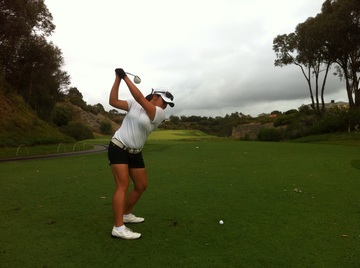 One of my junior golfers has developed a reverse pivot in her back-swing since I last saw her and has a big junior event next week. My advice to her and her parents is that she needs time over the next month to make the slight change to her spine angle to move it back to its original position. So the result is withdrawal from the tournament and time to focus and make the change over a month. She will test it out in club competitions during that period. During this cycle 70 percent of available time allotted to golf should be spent on technical improvement and 30 percent on playing holes. Jordan Spieth's coach when he started working with Jordan recognized instantly that his lower and upper body were working against each other so he got him started with just one drill to begin with and not try to change the whole swing. Jordan was very lucky that Australian PGA Trained Cameron McCormick understood the step by step golf swing change process required to make major swing changes. When Jordan started with his first drill, his first 50 practice balls were skulled (topped), chunked (fat) and not one shot got off the ground. But with the encouragement of McCormick (the North Texas PGA Teacher of the Year 2007 and PGA Teacher of the Year 2015) he made the changes necessary and went on to win two US Junior Championships. The only player to win more than one US Junior is a player named Tiger Woods. 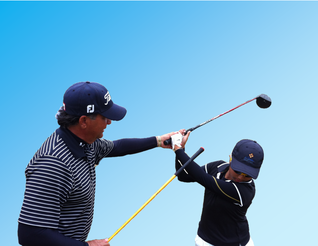 So what can we learn from these young superstars? We learn that the window of time for them to establish technical mastery of their golf swing was between the ages of 12 and 15 years old. This is done with a coach who has a complete understanding of how to implement a step by step long term development pathway, and also is able to communicate this process to the young junior and also their parents. By doing this the junior and parents commit fully, and by the time he/she gets to the age of 15 years old (from a technical point of view) they are almost fully developed and ready to for the next cycle which is a competitive cycle. This is when Rory, Jason, Jordan, Ryo and Matteo were ready to compete at a very high level - even against professionals when they were given the opportunity. In conclusion, understand where the window of opportunity for swing change is and align the junior with someone who truly understands the long term development pathway and has a track record of implementing it successfully. David Milne and Lawrie Montague - Pro Tour Golf College The Professional Golf Tour Training College for Serious Amateur Golfers  The question that is regularly asked of PTGC's co-director Lawrie Montague and myself by parents of junior golfers is how can their child emulate the success of young golfers like Rory McIlroy, Matteo Manessero, Ryo Ishikawa and Guan Tianliang? The answer is in understanding how junior golfers develop and Lawrie and I describe it as the "garden metaphor". What I mean is that garden plants develop and grow at their own pace and blossom at different times. Some will flower early and wilt early, whilst others will flower later and keep flowering the rest of their life; and some will never flower. There are some that grow quickly, and others take more time to reach maturity. Most plants need plenty of attention in their early years like watering and fertilizing to make them grow strong, and others can be left alone and will thrive. There are plants that require shade, and others that need the full sun. Some are solitary, whilst others need to grow in bunches. There are plants that are extremely hardy, and others are fragile and need nurturing. And in all of this, constant weeding is required to keep them from being overwhelmed. It is proven beyond doubt that all junior golfers (I mean flowers) grow and flourish best in their own natural environment. History has also shown that trying to make or change human beings into one model or one size fits all does not work. The same applies to developing a junior golfer on a long term player pathway. Each junior has to be guided and encouraged to be an individual in their development and be allowed to grow at their own pace to reach the full potential.  So the garden metaphor shows us that you can't and shouldn't rush junior golf development, and the reason below will be a guide as to why this is so. As in all junior sports physical size does matter in the early teenage years and most of the early developers tend to dominate junior golf as they are able to reach greens in regulation compared to the smaller - less developed juniors. The bigger and stronger juniors because of this advantage tend not to develop their green-side scrambling skills which in the long run will hold them back, and allow the other juniors to overtake them eventually. Those who are encouraged to improve all facets of their game keep dominating junior golf as they move through the age groups. The juniors who are exposed to and/or have access to good quality coaching, are the ones who also stay in the game longer as they tend to encounter less "road-blocks" along the pathway to being the best they can be. The coach will introduce training programs and systems designed for improvement that challenge the young golfer and guides him or her along a success pathway at their own pace. The junior who receives support from parents and golf associations should understand that not many juniors are going to be superstars, or winning professional events as teenagers. In fact the average age of professionals in the top twenty world golf rankings is 34.6 years. So there's no rush to get real good at golf; let the "garden metaphor" be the guide that allows your child (or the junior golfer you're working with) to reach their full potential. And it is important to understand that trying to shorten the development timelines is usually a recipe for failure; especially if the junior is your child. David Milne and Lawrie Montague - Pro Tour Golf College Your Success On Tour is Our Business |
Archives
June 2019
|
Proudly Supported By
Copyright © 2011 - 2018 Pro Tour Golf College
Website Managed By Golf Performance Media
All Rights Reserved
Website Managed By Golf Performance Media
All Rights Reserved











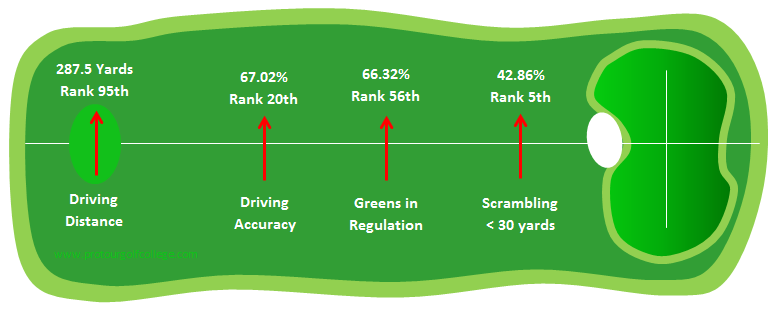


 RSS Feed
RSS Feed



